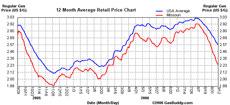Gas prices rise, affect commuters on campus

Gas prices rise, affect commuters on campus
With commuter students accounting for approximately 90 percent of Missouri Southern’s student body and some driving from Diamond and Pittsburg, Kan., the recent drop in gas prices is providing much-needed relief.
Commuting can be anything from a 10-minute drive from south Joplin to a 35-minute drive from Pittsburg. With more than 900 students commuting from outside the Joplin area the price of gas has been adding a steadily mounting financial strain.
“I have to go to class, [gas prices] are terrible, but I have to go,” said Chad Bowman, junior respiratory therapy major, who commutes from Carl Junction.
Many students, like Bowman, are taking advantage of distance learning with Internet courses available through Blackboard.
“Last spring we had more than 700 students who were strictly distance learners,” said Jack Spurlin, vice president of lifelong learning.
Classes are available through the Internet or Internet hybrid, TV, video correspondence or CD correspondence. With gas prices climbing into the $2.90 range at the beginning of the semester, registration for distance learning has also been on the rise.
“We see students who are commuting taking Internet courses so they only have to come to campus two days a week instead of five,” Spurlin said.
However, for those not enrolled in Internet courses, the high price of the drive to and from school has been limiting other aspects of students’ lives.
“I have both day and night classes so I try not to go anywhere but school,” said Amanda Brown, sophomore general business major.
Brown makes a daily commute from Diamond in her Ford Focus and estimates she spends almost $50 a week on gas.
“I have morning class so I drive to school, drive home, wait around and drive back, it’s a double trip,” said Brown. “Just staying home I still fill up the same amount but I’m definitely noticing a drop in the price.”
Though prices began dropping drastically in early August (when they peaked at $2.93) the stress is still there for students who not only commute to school but also drive elsewhere for classes. Justin Stone, junior respiratory therapy and general studies major, drives to school from Carl Junction as well as driving to clinicals.
“It’s a pretty big hit to the wallet since we have to drive to clinicals . . . it’s about $30 normally and $50 when we go [to clinicals],”said Stone.
Students in the respiratory therapy program as well as the nursing program travel to clinicals in Mt. Vernon, Tulsa, Fayetteville, Ark., and several others.
“We try to arrange it so [students] can carpool because we know it’s a long drive,” said Glenda Pippin, director of respiratory care.
However, with gas prices plummeting downward, reaching as low as $2.11 as of Sept. 12, perhaps driving to school will no longer break the bank for Southern’s commuters.
Your donation will support the student journalists of Missouri Southern State University. Your contribution will allow us to purchase equipment and cover our annual website hosting costs.



























